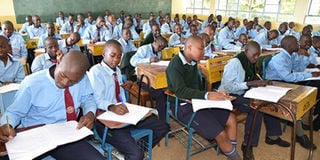Tough times for learners as teacher shortage bites

Form One students at St Peter's Mumias Boys study biology on January 17, 2019. Secondary schools are grappling with high student enrolment and teacher shortage. PHOTO | FILE | NATION MEDIA GROUP
What you need to know:
- Teachers Service Commission CEO Nancy Macharia says the shortage stands at 96,345: primary schools require 38,054 and secondary 58,291.
- Since the introduction of free primary education in 2003 and the resultant surge in enrolment from 5.9 million to about 10 million currently.
- The government is targeting to have 110,000 students in 11 national polytechnics, 1.4 million in 280 technical and vocational colleges and 1.6 million in technical vocational centres.
Technical and vocational colleges are in the grip of a severe teacher shortage that compounds an already explosive staffing problem in the entire education sector.
The country’s 150 Technical and Vocational Educational Training (TVET) colleges are short of more than 5,000 teachers, a situation that threatens the quality of learning and also puts some of the courses on offer at risk of being abandoned.
Dr Kevit Desai, the Principal Secretary of TVET, while acknowledging the staffing deficit, says they are in the process of hiring 2,000 teachers this year to help close the gap.
“We have interviewed 1,000 tutors and the hiring process is on course. We will then interview 1,000 more later this year hoping to make the process continuous and sustainable,” he says.
Besides the TVET colleges, the basic education sector is itself grappling with a massive teacher shortfall that comes in the middle of the introduction of the Competency-Based Curriculum and the campaign to achieve 100 per cent transition from primary to secondary schools.
At the same time, universities are preparing to kick out more than 4,000 lecturers who do not have doctorate degrees and are, therefore, ineligible to lecture in a new policy introduced in 2017.
ENROLMENT
Teachers Service Commission (TSC) chief executive Nancy Macharia says the shortage stands at 96,345: primary schools require 38,054 and secondary 58,291.
According to the commission’s Strategic Plan for 2019 to 2023, the shortage will reach 119,419 by 2023 with secondary schools hit hardest with a shortfall of 84,478 and primaries with 34,941.
In the last five years, the commission has recruited 28,843 teachers — 8,390 for primary and 20,453 for secondary.
Since the introduction of free primary education in 2003 and the resultant surge in enrolment from 5.9 million to about 10 million currently, the government has tended to concentrate on recruitment of primary school teachers.
It has now shifted attention to secondary schools, hoping to support the free day secondary education programme and the 100 per cent primary-secondary transition quest.
And, just like in basic education, the government is driving a huge enrolment campaign to TVET colleges despite the staffing handicap.
COMPETENCE
The student population in colleges stands at around 183,000 up from 98,000 only two years ago.
The teaching force stands at 3,780 compared with a requirement of about 8,000.
A government policy released late last year indicates that the ministry is targeting to increase the enrolment of students in technical and vocational training institutes from the current 180,000 to 3.1 million by attracting one million students annually and tapping the more than 500,000 students who fail to join universities in the country every year.
Dr Meshak Opwora, the Director, Technical Education in the State Department for Vocational and Technical Training, says they are working to close the teacher deficit incrementally.
However, the National Assembly’s Education Committee wants the recruitment stopped, claiming that some of the tutors being recruited have no teaching skills.
The committee that is chaired by Julius Melly (Tinderet) argues that the recruits do not meet the threshold of being tutors.
AMBITIOUS TARGET
Last year, the government moved 4,000 tutors in technical and vocational training institutions from the Teachers Service Commission (TSC) to the Public Service Commission due to its tough recruitment requirements.
Dr Desai cited TSC’s inability to recognise the qualifications of tutors who undergo training through the TVET training path in their career progression.
Dr Desai said that, for instance, a trainer with higher national diploma, who scored a C- at Form Four, could not be hired by TSC.
In the new plan, the government is targeting to have 110,000 students in 11 national polytechnics, 1.4 million in 280 technical and vocational colleges and 1.6 million in technical vocational centres.
At the university level, the situation is no different since the government plans to kick out all lecturers who have only a master’s degree in line with a scheme to have only those with at least a doctorate allowed to teach.
According to the Commission for University Education (CUE), about 53 per cent of all lecturers in the 70 public and private universities have only a master’s qualification.
UNIVERSITIES
The Commission for University Education’s latest situation report covering 2015-2016 notes that the increase in the number of lecturers with master’s degrees is commensurate with the high enrolment of undergraduate students, who are mainly taught by master’s degree holders.
The report adds that the percentage of academic staff with PhD qualification is only 32 per cent.
If the government goes ahead to implement this policy, it means that 53 per cent of 9,000 lecturers, or 4,400, who have master’s degrees, will be kicked out of the lecture halls, leaving about 4,200 to teach close to 600,000 students in universities.
However, the Universities Academic Staff Union is challenging the policy in court on grounds that it was not consulted.
The union also argues that CUE breached the Constitution, which calls for public participation before implementation of the policy.
CUE chief executive Mwenda Ntarangwi says the plan to reform university teaching is on course, but they have to wait for the legal process to be concluded.




